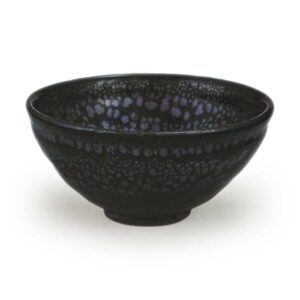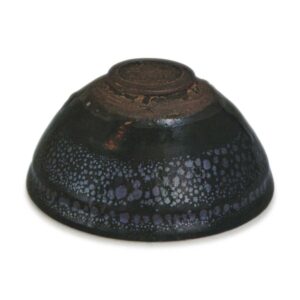

Fujita Art Museum
Height: 4.3cm
Diameter: 8.9cm
Base diameter: 3.2-3.3cm
Height: 0.3cm
This is an identical copy of the Ryuko-in Yuteki Tenmoku bowl, and was probably made at the same time and in the same kiln. Although they differ in size, I think they are all related.
As usual, the clay is white and coarse, but it has been covered with iron sand, so it is impossible to know the details. If you look at the illustration of the bowl upside down, you can see a pale area near the rim of the glaze, which looks like a finger mark, but even from this you can tell that the underlying clay is white. The construction is almost the same as that of the Ryuko-in bowl, but the band around the rim is somewhat loose, and this creates a subtle difference in appearance. However, the dimensions are almost the same, and it is an unusual small bowl, so it is possible to think that it was made at the same time by the same person.
There is a dark, rust-like substance on the base of the footring and inside the footring that is different from the clay used for the rest of the bowl. I think that the dirt from the tea stains that have stuck to the bowl may have come off over time, but I’m not sure. This is a phenomenon that is not seen on the Ryuko-in bowl.
The glaze and the appearance of the oil spots are quite different from the previous work. This is particularly noticeable on the exterior. If you look at the image of the bowl upside down, you can see that the oil spots are limited to the top half. This is because the underglaze was applied shallowly and did not reach the foot ring. Therefore, the foot ring has no underglaze, and only a pale, candy-like overglaze was applied, resulting in a different color and no oil spots.
The appearance of the oil spots is not as uniform as those on the Ryuko-in bowl. There are many large spots, and these are interspersed with smaller ones. The shape of the large spots is often irregular. The oil spots are silvery with a bluish tinge, and the way they shine in a jumble of large and small spots is just like the Milky Way on a clear autumn night. It has a different, mysterious beauty to that of the Ryuko-in bowl. The production area of this type of Yudeki Tenmoku bowl has long been said to be the Taigu kiln in Shanxi Province, but after the war, the Chinese academic community reported that the Taigu kiln was a misnomer and that it was actually the Jiaoxiu kiln. However, it is not known exactly what excavated pottery fragments have been found at the Jiaoxiu kiln.
Nothing remains of the history of this tea bowl before it came into the Fujita family. Judging from the fact that it is accompanied by a beautiful bowl-shaped stand made of blue shell and stored in a black lacquered box, it must have had considerable history.



